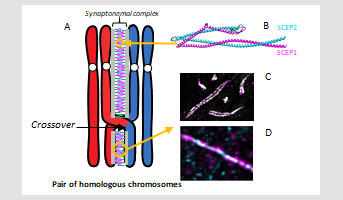SCEP1 and SCEP2 are essential for meiosis in Arabidopsis thaliana
In this work, two new small proteins called SCEP1 and SCEP2 were identified and characterized. The structural predictions obtained with Alphafold suggest that these two proteins form a complex that has been detected at the center of the synaptonemal complex in the Arabidopsis thaliana plant. When SCEP1 and/or SCEP2 are not expressed, the synaptonemal complex is no longer formed, there are more crossovers per chromosome pair but some chromosomes do not receive crossovers, resulting in defects in gamete formation and a drop in plant fertility. These two proteins therefore play a central role in meiosis, and therefore in sexual reproduction.
Proteins similar to SCEP1 and SCEP2 have been found and predicted to form a structural complex similar to that of the Arabidopsis proteins in the majority of representative flowering plant species.
Back

Legend: SCEP1 and SCEP2 co-localize at the center of the Synaptonemal Complex
A: In meiosis, each pair of homologous chromosomes is physically associated by a crossover and by a protein structure called the Synaptonemal Complex.
B: Structure of SCEP1 and SCEP2 predicted by AI Alphafold2
C: SCEP1 (Magenta) is visualized at the center of the synaptonemal complex (grey)
D: SCEP1 (Magenta) and SCEP2 (Blue) colocalize at the center of the synaptonemal complex
Scientific contact:
Christine Mézard, contact
Institut Jean-Pierre Bourgin (INRAE, AgroParisTech)
"Meiosis Mechanisms" MeioMe team
Associated division:
BAP
Associated centre:
Ile-de-France - Versailles-Saclay
Référence :
Nathalie Vrielynck, Marion Peuch, Stéphanie Durand, Qichao Lian, Aurélie Chambon, Aurélie Hurel, Julie Guérin, Raphaël Guérois, Raphaël Mercier, Mathilde Grelon & Christine Mézard. SCEP1 and SCEP2 are two new components of the synaptonemal complex central element. Nature Plants, novembre 2023, DOI : https://doi.org/10.1038/s41477-023-01558-y
More information :
Press release INRAE 16/11/23, link